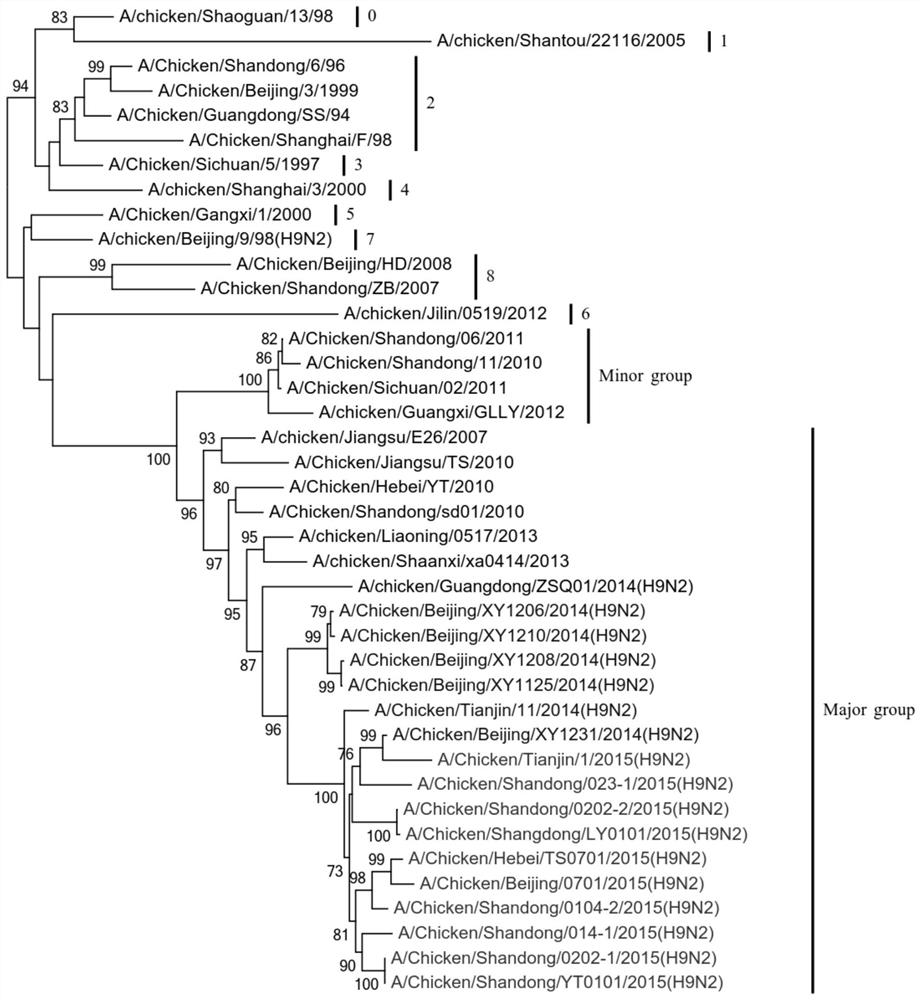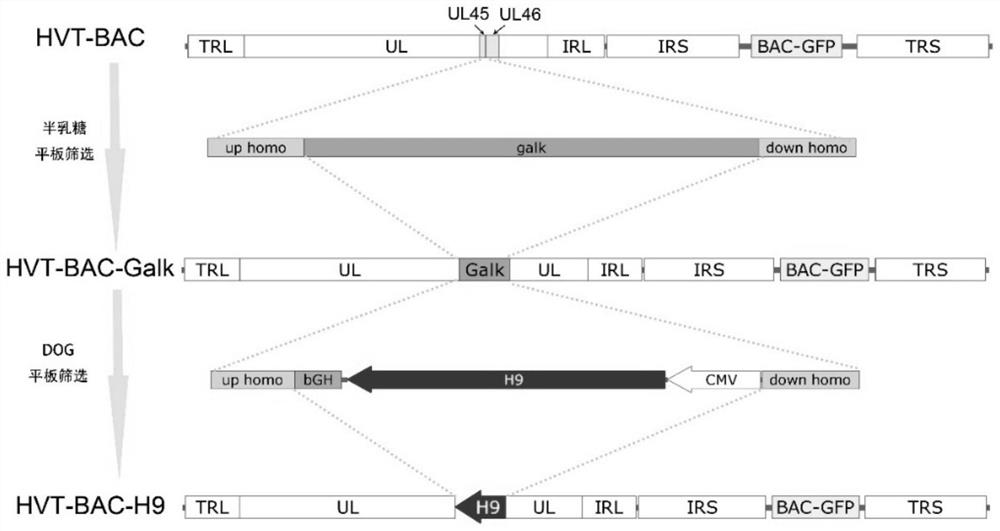A recombinant turkey herpes virus expressing h9 protein of h9n2 subtype avian influenza virus
A technology for turkey herpes virus and avian influenza virus, applied in the direction of double-stranded DNA virus, antisense single-stranded RNA virus, virus, etc., can solve the problem of reducing chicken excretion, failing to effectively control the prevalence of H9N2 subtype AIV, and virus antigenic variation. And other issues
- Summary
- Abstract
- Description
- Claims
- Application Information
AI Technical Summary
Problems solved by technology
Method used
Image
Examples
Embodiment 1
[0054] Example 1, A / Chicken / Beijing / 0701 / 2015 (H9N2) (hereinafter referred to as A / Chicken / Beijing / 0701 / 2015, BJ / 15 virus strain or CK / BJ / 1 / 15) acquisition and identification
[0055] 1. Isolation and identification of H9N2 influenza virus
[0056] The inventor of the present invention collected throat swab samples of chickens from Beijing, Tianjin, Hebei, Shandong and other places in my country between 2014 and 2015, and then referred to the literature (Pu juan et al.Evolution of the H9N2influenzagenotype that facilitated the genesis of the novel The method described in H7N9virus.Proc Natl AcadSci US A.2015.), the relevant virus of sample is isolated and identified. Among them, 16 strains of H9N2 avian influenza virus were isolated. According to the general nomenclature of influenza viruses, the 16 isolated strains of H9N2 avian influenza viruses were named, and the specific information is shown in Table 1-1.
[0057] Table 1-1. Basic information of H9N2 avian influenza viru...
Embodiment 2
[0091] Embodiment 2, the preparation of the recombinant turkey herpes virus (i.e. recombinant virus rHVT-H9) expressing H9N2 subtype avian influenza virus H9 protein
[0092] 1. Construction of recombinant plasmid pBAC-GFP-US
[0093] 1. The nucleotide sequence of the GFP gene (NCBI sequence number: LC336974.1) was artificially synthesized and inserted into the pUC19 vector to construct the plasmid pUC-GFP. The plasmid pUC-GFP was used as a template, and a primer pair consisting of GFP-F and GFP-R was used for PCR amplification to obtain a DNA fragment of about 720 bp.
[0094] 2. Take the DNA fragment obtained in step 1, perform double digestion with restriction endonucleases NheI and XbaI, and recover the digested fragment.
[0095] 3. Take the pcDNA3.1+ vector, perform double digestion with restriction endonucleases NheI and XbaI, and recover a vector skeleton of about 5.4 kb.
[0096] 4. Ligate the restriction fragment obtained in step 2 with the vector backbone obtained...
Embodiment 3
[0151] Embodiment 3, identification of recombinant virus rHVT-H9
[0152] 1. Gene level identification
[0153] Genomic DNA of the recombinant virus rHVT-H9 was extracted and used as a template to perform PCR amplification with a primer pair composed of H9-F and H9-R to obtain PCR amplification products.
[0154] The results showed that the PCR amplification product contained a DNA fragment of about 1683bp. It can be seen that the H9 gene has been completely inserted into the HVT genome.
[0155] 2. Indirect immunofluorescence identification
[0156] 1. Take a 24-well cell culture plate and add 500 μL of culture medium containing CEF cells (about 2.25×10 5 CEF cells / well), 37°C, 5% CO 2 Culture until CEF cells grow into a monolayer.
[0157] 2. After completing step 1, inoculate the recombinant virus rHVT-H9 (the inoculation dose is 100PFU / well), at 37°C, 5% CO 2 Cultivate for 72h.
[0158] 3. After completing step 2, discard the medium, wash once with PBS buffer soluti...
PUM
 Login to View More
Login to View More Abstract
Description
Claims
Application Information
 Login to View More
Login to View More - R&D
- Intellectual Property
- Life Sciences
- Materials
- Tech Scout
- Unparalleled Data Quality
- Higher Quality Content
- 60% Fewer Hallucinations
Browse by: Latest US Patents, China's latest patents, Technical Efficacy Thesaurus, Application Domain, Technology Topic, Popular Technical Reports.
© 2025 PatSnap. All rights reserved.Legal|Privacy policy|Modern Slavery Act Transparency Statement|Sitemap|About US| Contact US: help@patsnap.com



